16+ Must-See Campy Horror Movies
Here all the best campy horror movies to stream tonight.
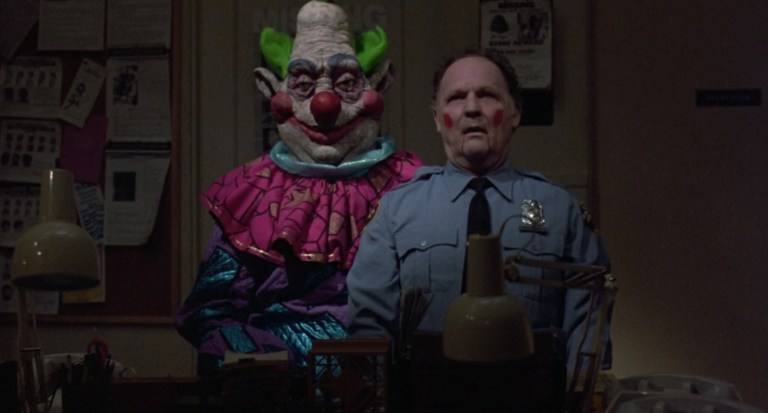
Table of Contents
It’s supposed to be bad. It’s not taking itself seriously. She’s acting that way on purpose. It’s camp.
Camp: An ever-elusive term in cinematic history and culture beyond (recently evidenced by the haphazard 2019 camp-themed Met Gala) isn’t exactly definable within strict parameters. From intentional absurdity to accidental self-parody, camp often comes up when referring to anything over-the-top — anything in which exaggeration plays a pivotal factor. In films, sometimes the dialogue is so quippy it’s cringe-worthy. Other times, the narrative is so far-fetched that it’s implausibly laughable.
When it comes to campy horror movies, the extravagance is applied to the morbid and macabre, resulting in blood-splattering action sequences to the tune of rock ballads, endless one-liners, and characters who wear their personalities like costumes.
A villain who is physically unassuming or improbably threatening often breeds the “goofy villain” assortment of camp films. Can a tomato be a villain? How about a tree stump? It can be if it’s not taking itself seriously. In this instance, the antagonist is the “camp factor:” the aspect that offsets the otherwise eerie atmosphere and scary story.
There’s also a strong link between cheesiness and camp; the reign of 80s cheese-fest films suggests that many horror enthusiasts appreciate a touch of tackiness with their terror. When employed well (whether intentionally or not), corny catchphrases and far-fetched dialogue can supplement a basic horror format to achieve “stickiness,” or cultural memorability.
This list will highlight camp horror classics of various types (and other-lesser-known campy films) that deserve a spot on your Halloween watch list.
Top Campy Horror Movies
The Blob (1958)

The Blob is a B movie that has become a cult classic via gooey galore and a then- up-and-coming Steve McQueen. The sci-fi scare features a gelatinous alien creature determined to engulf Phoenixville and Downingtown, Pennsylvania. Of course, a couple of teenagers are the only ones who see the monster absorb (swallow?) an elderly man, and the police refuse to believe that such a creature exists until the situation grows dire.
The creature arguably represents fear itself — all-consuming and inescapable. Thus, it should come as no surprise that the film premiered soon after the peak of The Cold War, in which a lingering sense of doom was always present.
The Blob was corny and tacky for the ‘50s, so its dated graphics and small-town generation wars only add to today’s perceived campiness. And who could forget the catchy tune — reminiscent of both The Beach Boys’ discography and “The Monster Mash” — that opens the film, “Beware of the blob, it creeps and leaps and glides and slides.”
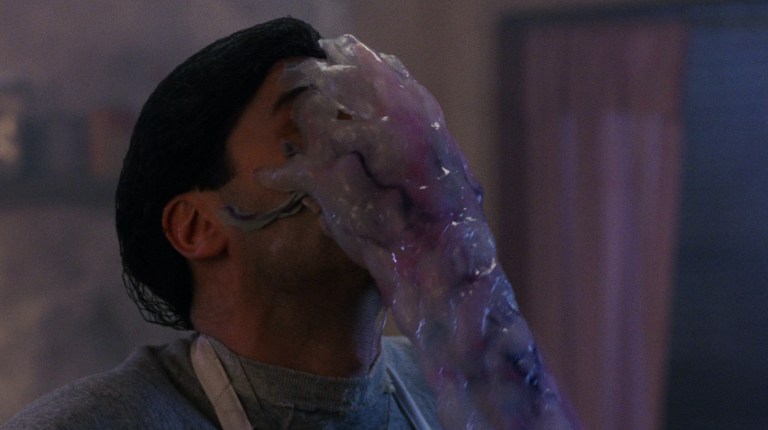
The 1988 remake stepped right into its predecessor’s B-movie shoes but added in shady government scientists trying to contain the creature. This time around, the gooey monster is no longer an alien, but the product of a Cold War-era biological warfare experiment gone awry.
Young Frankenstein (1974)
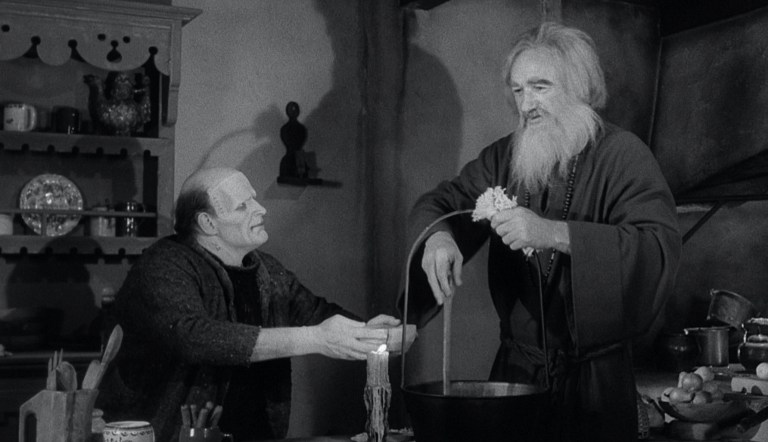
Young Frankenstein is a fully self-aware spoof on the original fright fest, capitalizing on Gene Wilder’s knack for eccentricity and sharp comedic timing. Wilder portrays the grandson of the infamous scientist, Frederick Frankenstein, as he struggles to prove his deceased grandfather’s sanity. When invited to Transylvania, he discovers how to reanimate the dead, giving life to Peter Boyle’s monster.
Young Frankenstein pays homage to the original 1931 classic, showing that where there is good parody, there must be admiration. The movie is filmed in black and white and places exaggerated under-eye makeup on Wilder to visually dramatize his performance, as was done in the 1930s.
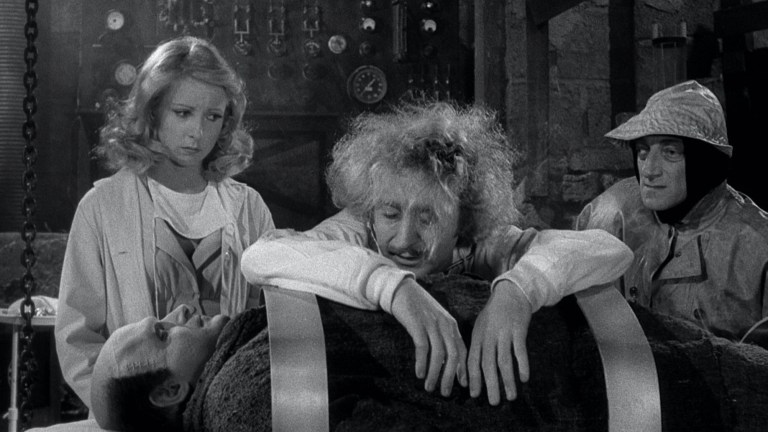
Director Mel Brooks does not tinker with classic horror tropes to achieve humor via gimmick. Rather, he is perfectly faithful (sans some fourth-wall breaking) to the cinematic approach of a bygone age, which, 50s years later, operates as a parody in and of itself. Not to mention, Wilder and Boyle play their parts with utter solemnity, wholly unaware of the fact that they are in a comedy.
As is the case with many movies on this list, there is a brief musical number, in which the Monster and Frankenstein perform “Puttin’ on the Ritz.” Boyle’s rigid movements and off-pitch gibberish are laugh-out-loud funny. It’s corny. It’s cooky. It’s outlandish. And the clever one-liners just keep coming.
Brooks is also the creative genius behind the comedy horror Dracula: Dead and Loving It, which also benefits from his signature flare for gothic comedy. In short, these two movies make for a complementary double feature night.
The Rocky Horror Picture Show (1975)
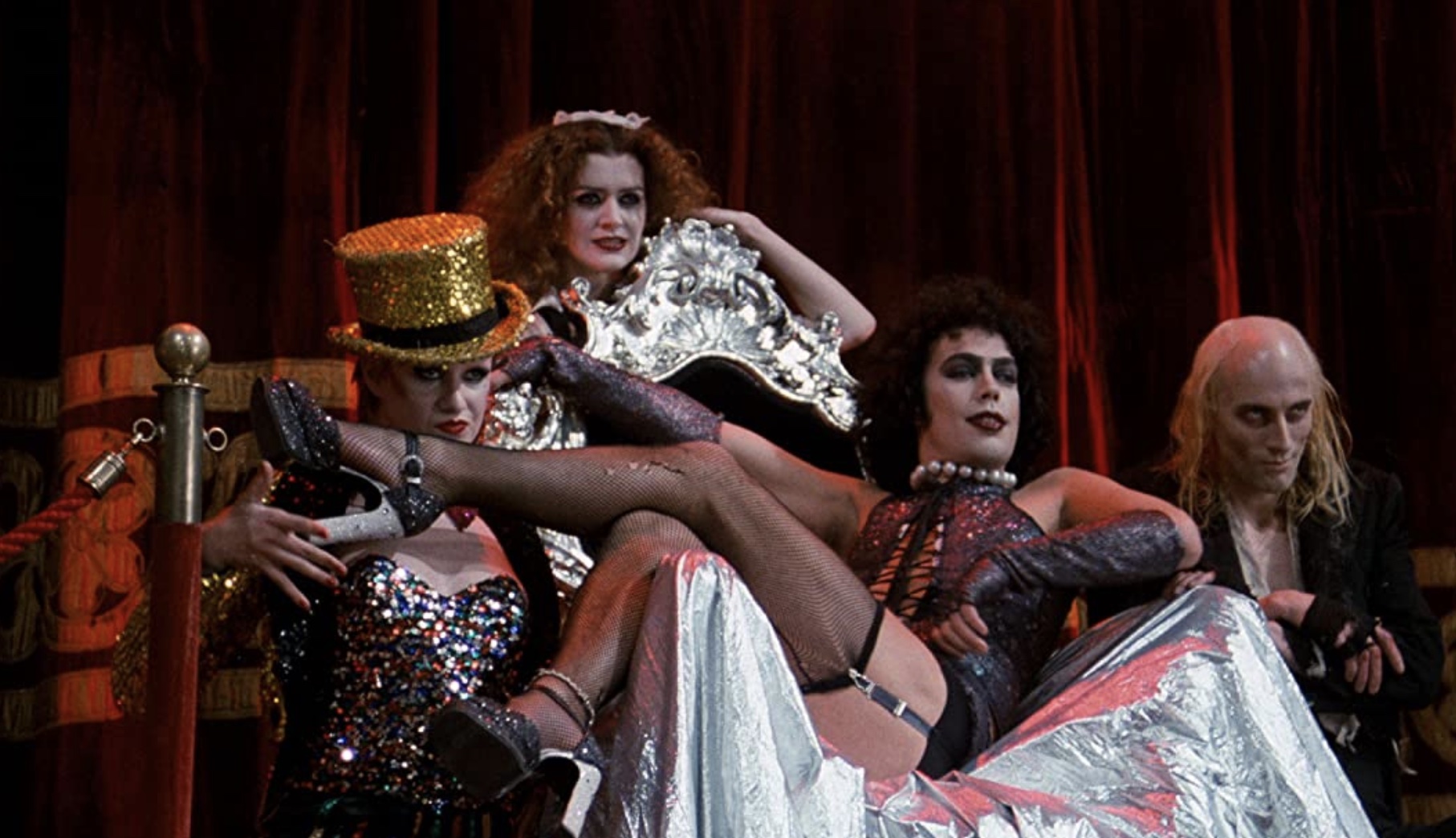
“With the bit of a mind flip,” you suspend your disbelief. You enter Dr. Franken N. Furter’s castle and become one with his motley crew of misfits. The Rocky Horror Picture Show follows a young engaged couple whose car breaks down outside Furter’s castle. They enter his home looking for a telephone, but they get much more than they were seeking via hypersexual performances and a laboratory-made muscle man “with blonde hair and a tan.”
The film promotes uniqueness and inclusivity. It celebrates those who do not fit in the gender binary, those who experience same-sex attraction, those who flaunt their feminity and masculinity equally — those who have been pushed to the fringes of Hollywood’s frame for far too long. It’s a film ahead of its time and it’s oh-so-fun with a soundtrack to die for.
The Rocky Horror Picture Show is the definition of both a camp and a cult classic. Over-the-top does not begin to define this outrageous splendor. There’s tap dancing, a motorcycle riding Meat Loaf, a garbed-in-leather Tim Curry, and a frequently fainting Susan Sarandon…and a talking pair of lips…Oh, and the caste is actually a spaceship.
Sleepaway Camp (1983)
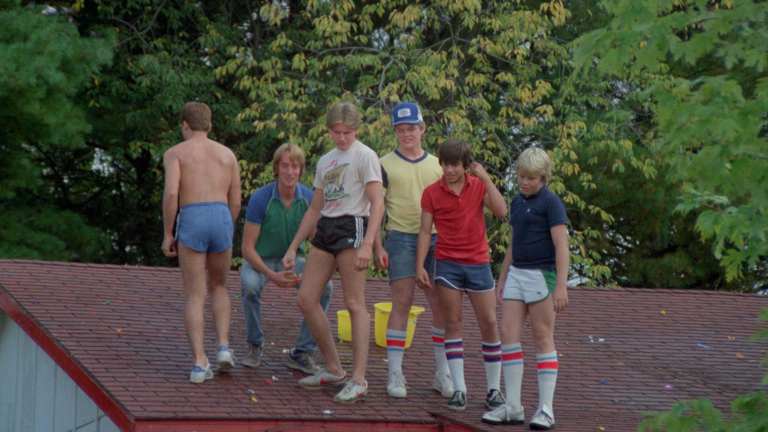
Sleepaway Camp may have been yet another slasher film to come out of the 1980s, but it stands in a league all its own. Boasting a twist-ending that remains one of the most critically celebrated plot shocks of all time, the movie has earned its place on the roster of classic horror films.
The film has a lot to say about bullying and abuse, and it manages to work homosexuality and hormonal impulses into its narrative quite seamlessly. Despite Sleepaway Camp’s low-budget, which could have plagued the movie, each kill is remarkably unique and unpredictable, and the film balances its comic impulses with a Friday the 13th-like scare format. It’s tawdry. It’s filled with subpar acting. And it’s cheap…until it’s not.
The film has been said to pull inspiration from John Waters — one of the “grandfathers of cult cinema” best known for directing boundary-pushing comedies like Pink Flamingos (1972), Hairspray (1988), and Cry Baby (1990).
Gremlins (1984)
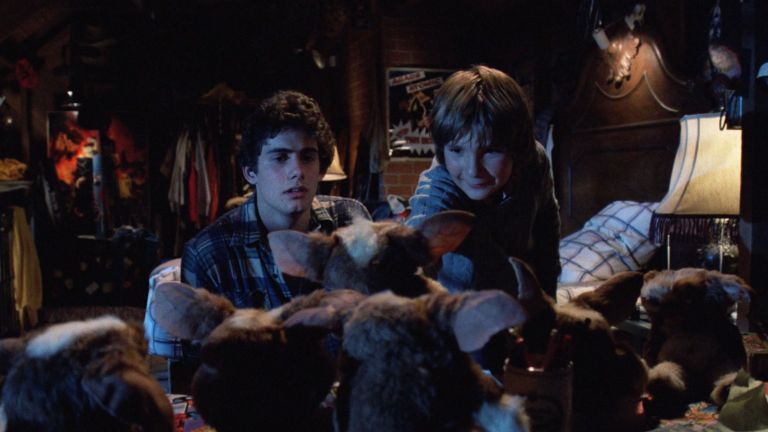
Cute creatures with cartoony eyes become diabolical menaces in Gremlins. Steven Spielberg’s 1984 black comedy horror follows a young man after he receives a new pet, a mogwai. The mogwai seems innocent until it begins spawning versions of itself that turn into treacherous torturers. Mogwai are rare, sentient, and innocent. Feed them after midnight and they become mischievous monsters on a macabre mission.
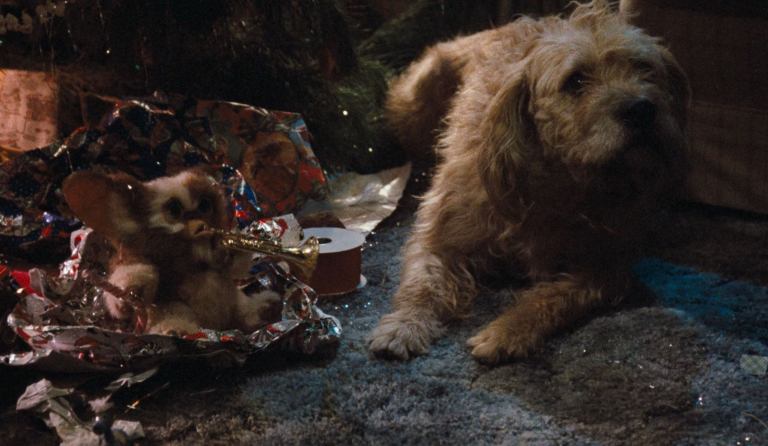
The gremlins are roughly two feet tall, but, for some reason, fully grown adults cannot compete with their aggression. It’s ridiculous. It’s a wacky spectacle with multiple high-octane action sequences shot against a Christmas-time backdrop.
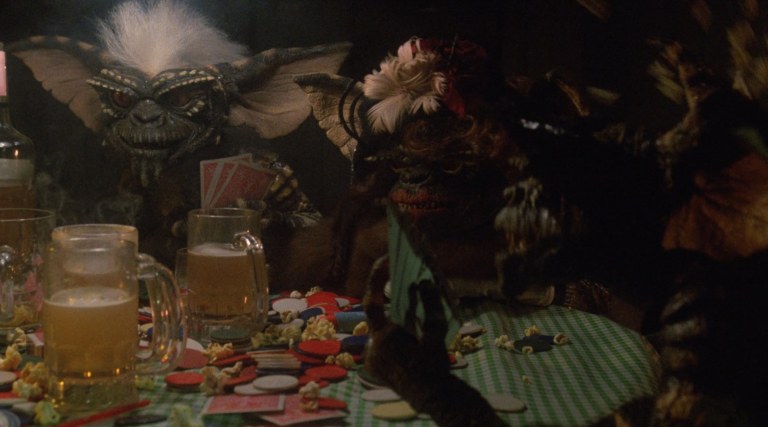
There’s also a dash of commentary with the yuletide season pitting the gremlins up against the values that Christmas should represent (despite the holiday’s increasing commercialization). And there’s little doubt that the film’s fictional town of Kingston Falls alludes to Bedford Falls from A Wonderful Life. Leave it to Spielberg to create a family-friendly classic that is both a scream-laden popcorn flick and a reflection on consumer culture.
Ghoulies (1985)
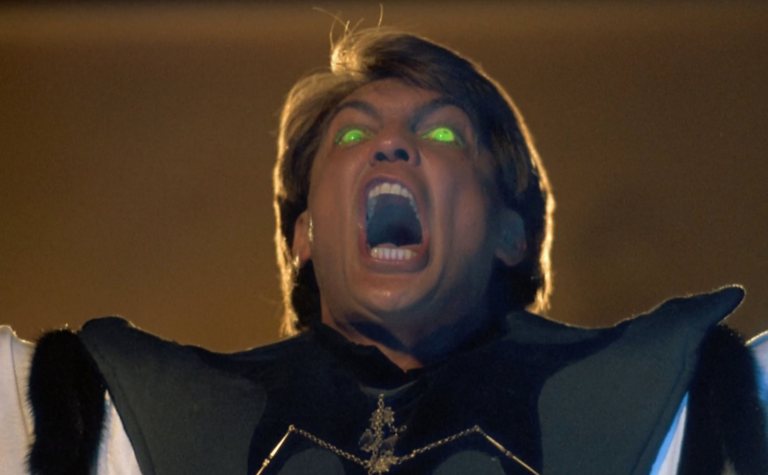
Following the release of 1984’s Gremlins, several films placing little critters and crawlers at the forefront began popping up in cinemas across the nation. From Critters to Ghoulies, tiny terrors became all the rage in the mid-to-late ‘80s. And who could forget Chucky, the three-foot-tall demonic doll?
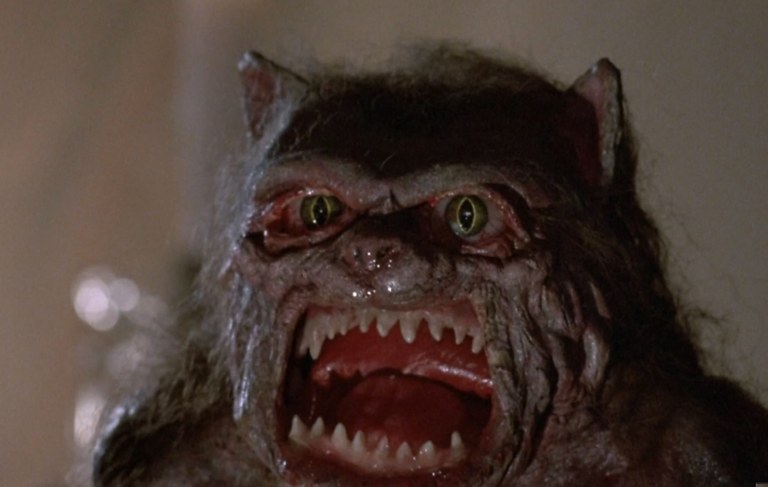
The Luca Bercovici-directed film follows a young man and his girlfriend who move into an old mansion, where they perform a magical ritual to give rise to the ghoulies. Yet, Jonathan happens to be the son of a man who nearly sacrificed him in a satanic ritual decades earlier. Jonathan ends up resurrecting his evil father who comes to proclaim himself as the “Master of the Ghoulies” before commencing his killing spree. Three more films came out following the original, and the franchise ended in 1994.
The first film is a cheesy, low-budget movie with a ton of cursing and violence. Put potty mouths on imp-like creatures and place one at the piano to serenade you between frights and you’ve got camp.
The Return of the Living Dead (1985)

Take zombies, add an ‘80s punk aesthetic, and you get The Return of the Living Dead. The film is a flippant homage to George A Romero’s portfolio of ‘60s and ‘70s zombie flicks like Night of the Living Dead and Dawn of the Dead.
The film follows two blathering buffoons who accidentally release a deadly gas into the air while working at a medical supply warehouse. The vapors cause the dead to rise from their graves and wreak havoc as zombies. The movie seamlessly merges comedy and terror, as limbs unattached to bodies still function and zombies without heads fumble around. The film also benefits from perfectly-timed needle drops that make this horror venture feel a little bit like a Halloween bash.
And let’s not forget the famous quote, “It’s not a bad question Burt,” which protagonist Frank utters each time the characters concoct a plan — ripped straight from Romero’s films — that doesn’t work.
Return of the Living Dead is well aware of its kitschy nature, yet the spoof comedy series manages to breed new life into the space. This zombie tale does not adhere to the quintessential thematic undertone of “humans are the true monster;” rather, it suggests that “the man is a moron,” and humanity’s self-indulgent stupidity will be the end of us. It’s laugh-out-loud funny in the most regretful way, but it doesn’t skimp on the blood, guts, violence, and profanity in aiming for comedy.
A Nightmare on Elm Street 2: Freddy’s Revenge (1985)

The follow-up to 1984’s A Nightmare on Elm Street sees the return of the delectable nightmare-lurking Freddy Kreuger, but the villain’s zaniness soars to unforeseen heights. From peeling his head away and uttering “you’ve got the body. I’ve got the brain” to chewing on an innocent girl’s leg as if it’s corn on the cob, Robert Englund sinks his teeth into the increasingly-flamboyant Kreuger. He’s the perfect combination of creep and camp.
Critics have deemed the film one of the worst in the series, but fans of the franchise praise the movie’s homoerotic undertones and the not-so-subtextual queer awakening at play. Unfortunately, despite the film’s progress in representation, its narrative resorts to heteronormativity. Homoerotic predicaments often end with Krueger’s violence, implying that homosexuality is deserving of punishment (a homophobic response that the leading protagonist has seemingly internalized).
Freddy’s Revenge is sloppily constructed and suffers from a few plot holes, but the film is largely responsible for setting Englund’s path to becoming one of the most celebrated playful villains — the one whose manic monologues are just as intriguing as his masochistic murders.
Beetlejuice (1988)

Beetlejuice! Beetlejuice! Beetlejuice! Say it three times to summon the demon — a demon playfully portrayed by a cockroach-eating, green-goop-covered Michael Keaton who talks with a ceaseless and edgy rasp. Yet, despite his grotesque appearance, he conjures an indelible charm that he uses to manipulate an innocent child, Winona Ryder’s Lydia Deetz.
Lydia is the daughter of two unbearable parents whose morals have been replaced by money. The family has moved into the house where a young deceased couple, Adam (Alec Baldwin) and Barbra (Geena Davis) remain as spirits. The couple does everything in their power to scare the new couple away, teaming up with Lydia and a not-to-be-trusted Beetlejuice.
The oh-so-ordinary Adam and Barbara score laugh after laugh while trying to adjust to the quirky underworld — where there just so happens to be a waiting room. Even in death, there are lines. Their everyday personalities work to juxtapose Keaton’s intentional campiness, ensuring that the film doesn’t fall into the camp-to-crap trap. This is a critically-acclaimed masterpiece, and though it sometimes goes off the rails, Beetlejuice remains an imaginative and visually stunning fun-for-the-whole family film.
Killer Klowns From Outer Space (1988)

The narrative is pretty much the title: aliens that look like clowns come down from outer space to terrorize a small town. The extraterrestrial clowns are on a mission to harvest and eat as many people as possible.
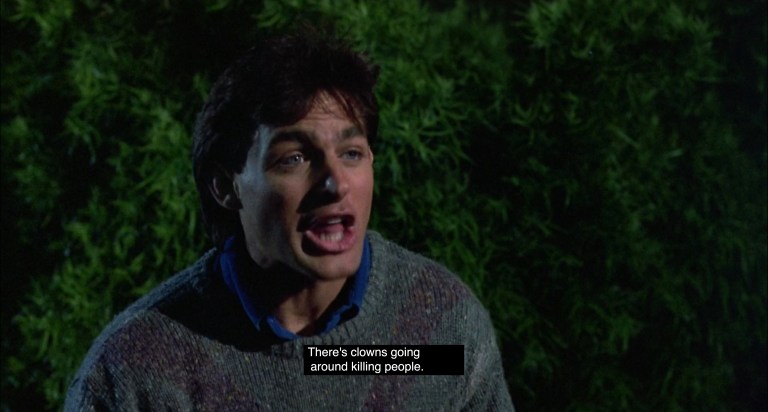
In this instance, the “camp factor” is pretty much on the nose. The concept itself is corny, and when a clown throws a punch in a red boxing glove to send a bully’s head into the nearby trash can, you can’t help but smirk (even if it’s accompanied by an eye-roll). The metaphor — the man is garbage — is only a little heavy-handed, but such overt messaging is part of the film’s charm. One Klown even uses shadow puppets to shrink his prey down before placing them in a bag of popcorn…but the popcorn turns out to be Klowns in Larval form.
The movie is quite imaginative with impressive special effects for the 1980s. The makeup work sinks these creepy clowns directly into your subconscious, for they are quite visually unsettling — giving Pennywise a run for his money. Though rough around the edges with overt hokiness that often diminishes any possible sense of horror, the unparalleled absurdity of it all stands the test of time.
Death Becomes Her (1992)
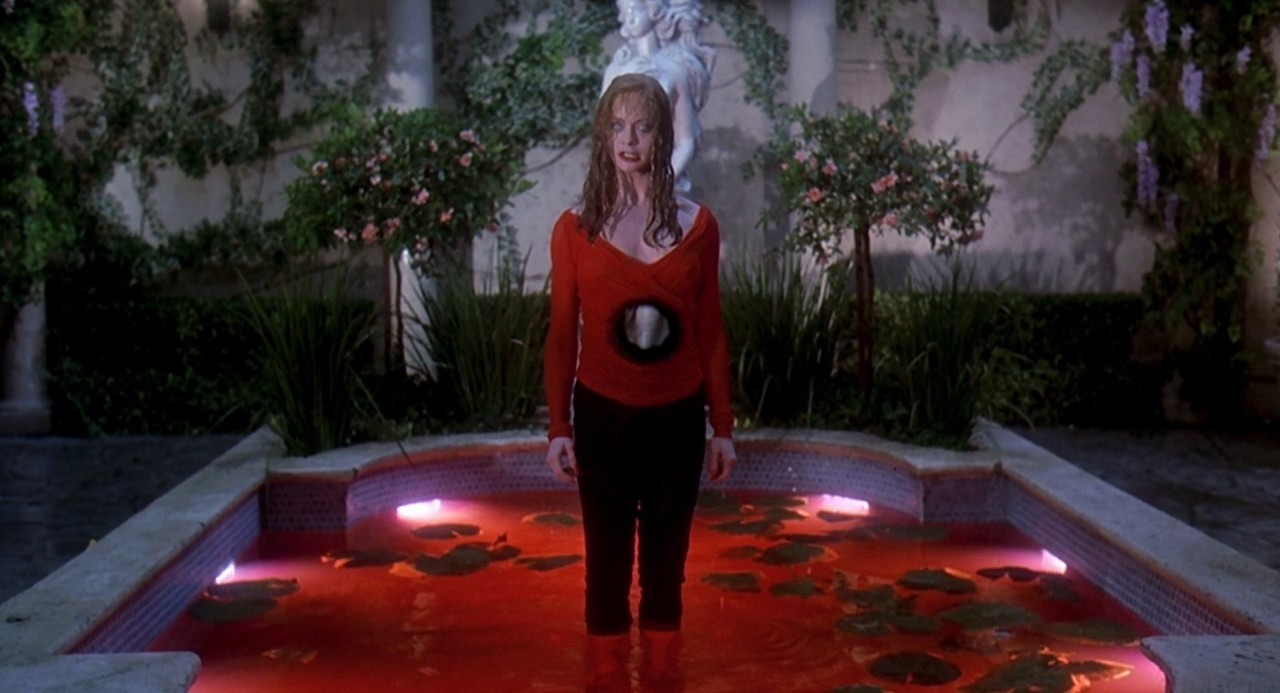
Death Becomes Her fits more into the black comedy/ fantasy sector of films, but its brief moments of terror and unpredictability warrant its place on this list. Directed and produced by Robert Zemeckis (Back to the Future, Cast Away, Forrest Gump), the film stars Meryl Streep and Goldie Hawn as bitter rivals who ingest an immortality potion. And don’t forget Bruce Willis as the man caught in the middle.
Though Death Becomes Her is not the empathetic reflection on female vanity that it sets out to be, it is nonetheless an entertaining exposé on melodramatic delivery and delicious tastelessness. Critics panned the film for its lack of depth, but who needs depth when you can have glamor and glitz in abundance?
Hawn and Streep play off each other so seamlessly, hurling insults back and forth with ease, each trying to assert their superiority and status above the other. The flick of a wrist, feigned excitement, strained decorum, a second-too-long piercing stare. It’s all there, and this cast eats it up.
The film, as many campy splendors do, opens with Streep’s Madeline Ashton performing a musical number, “I See Me,” on Broadway. Some of the lyrics: “I see me, I see me. Actress, woman, star, and lover. Sister, sweetheart, slave, and mother. I see me… and I like what I see.”
The film makes it known from frame one that it will comment on superficiality before going off the rails. In the end, when everyone else has died, the frenemies are left spray painting their skin color back on and reattaching their limbs whenever they fall off. Oh, and Hawn’s Helen Sharp ends up with a huge hole in her stomach after Ashton shoots her with a shotgun and throws a broken shovel through her in a manner reminiscent of target practice. It is an oddity. It is a quirky mess. But, its all-star ensemble makes Death Becomes Her unforgettable.
Leprechaun (1993)
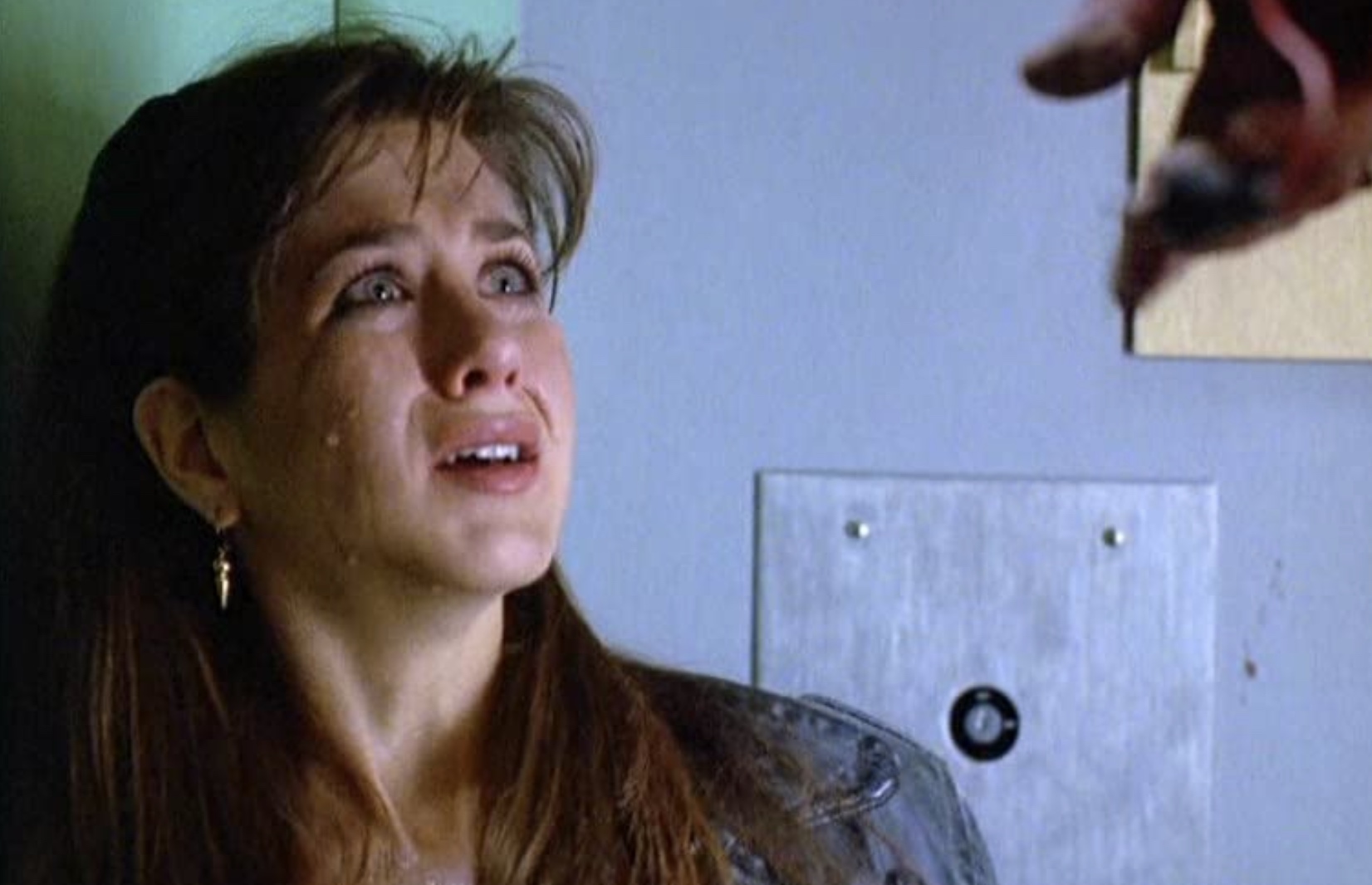
Go to the freezer, grab the vodka, and make a cocktail for this one; it’s not meant to be watched sober. Leprechaun stars Warwick Davis (Labyrinth, Willow) as the titular character across from Jennifer Aniston in her film debut. The leprechaun believes a family has stolen his pot of gold and said family attempts to locate it to appease him.
There is no way to get through this film without suspending every ounce of rational thought you possess. Take greed and add evil intent, and you get Warwick’s seedy, human-biting villain who seamlessly meshes existing folklore with manic masochism. Unfortunately, his creative performance is somewhat wasted on a nonsense narrative. Yet, the film has achieved cult status over the years and has even catalyzed seven follow-up films.
The first film is rarely scary and not exactly ha-ha funny, but in starting with a silly premise and taking itself seriously from that point forward, it belongs among the campiest films out there. Though originally intended as a straightforward horror, this is a clear example of “accidental camp” that worked toward the film’s benefit. The leprechaun’s sadistic nature and wise-cracking attitude, paired with his non-threatening physical form, lands this film squarely in the goofy villain realm.
Dead Alive (1993)

Peter Jackson (yes, the same man celebrated for Lord of the Rings) directed and helped pen the 1992 zombie comedy Dead Alive, which follows a young man and his overbearing mother after she’s bitten by a Sumatran rat-monkey. She dies and comes back to life with an urge to kill and eat her prey. Though her son attempts to lock her in the basement, she infects her neighbors with each escape, turning half the town into the walking dead. It only gets worse when the zombies crash a high-society party.
The film does not shy away from intense gore but the blood bath is choreographed through a lighthearted and comedic lens, as our protagonist (covered in gooey guts) plants a smooch on his loved one before ziplining her to safety in picturesque Tarzan fashion. The movie managed to incorporate some innovative special effects despite the guerilla filmmaking process and a measly $3 million budget.
The dialogue is also pure amusement with lines like “Your mother ate my dog,” “I’m not scared of you, mum,” and “I kick ass for the lord,” standing out as some of the most memorable in the bunch.
Hocus Pocus (1993)

1993’s Hocus Pocus stars Bette Midler, Kathy Najimy, and Sarah Jessica Parker as three witchy sisters who rise from the dead to suck the youth from children. The film was a critical failure and a box office flop. Yet, over the years, with help from ABC Family, the movie has become quite the cult classic, with a sequel even premiering on September 30, 2022.
Midler plays the leader of the pack with stringent authority and manic impatience, while SJP and Najimy play her obedient sisters — the former a flirt, and the latter a fool. Their performances are overly theatrical and their ridiculous hair-dos and Midler’s buck teeth only add to the film’s sense of frivolity. Each facial expression lingers a second too long. Each line of dialogue contributes to the caricaturing (over characterizing) of each witch.
With a couple of musical numbers and the 17th-century witches’ inability to adjust to the modern age, the film leans into comedy over horror, and it is sure to put a spell on the whole family.
Bubba Ho-Tep (2003)

Elvis has entered the nursing home. Bubba Ho-Tep stars Evil Dead icon Bruce Campbell as a man who claims to be the very-much-alive King of Rock and Roll across from Ossie Davis’ (Grumpy Old Men, Jungle Fever) “Black” JFK. (Black is in quotation marks here, because Jack, who claims to be JFK, reports that his skin color was dyed after an assassination attempt.)
The duo, though skeptical of one another, team up in a fight against a wayward mummy who sucks the souls from the elderly via their buttholes. Elvis dubs the soul-sucking Egyptian mummy Bubba Ho-Tep after experiencing a telepathic flashback of the mummy’s life and death.
Though the film is quite tongue-in-cheek with plenty of toilet humor strung throughout, it packs a punch in contemplating the oddities associated with fame and extravagance. What it lacks in frights, it makes up for in humor and charm.
The chemistry between Campbell and Davis is palpable. They somehow manage to make the preposterous heartwarming, gaining favors with critics and open-minded Elvis enthusiasts along the way. Not to mention, what beats the idea of these two legends squaring off against a zombie? Is it sometimes too audacious for its own good? Yes, but it’s worth the ride.
Cabin in the Woods (2012)
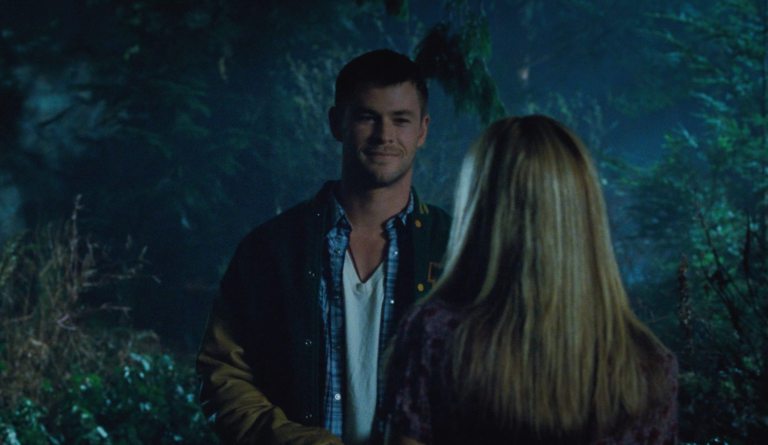
Cabin in the Woods may possess several campy elements, but unlike a handful of other installments on this list, it is also quite terrifying. The film follows five friends who travel to a remote cabin where they get much more than they bargained for. In an underground laboratory, two scientists are controlling the young adults from afar — releasing mind-altering drugs that inhibit their rational thinking, increase their libido, and more. And zombies lurk outside ready to kill them all.
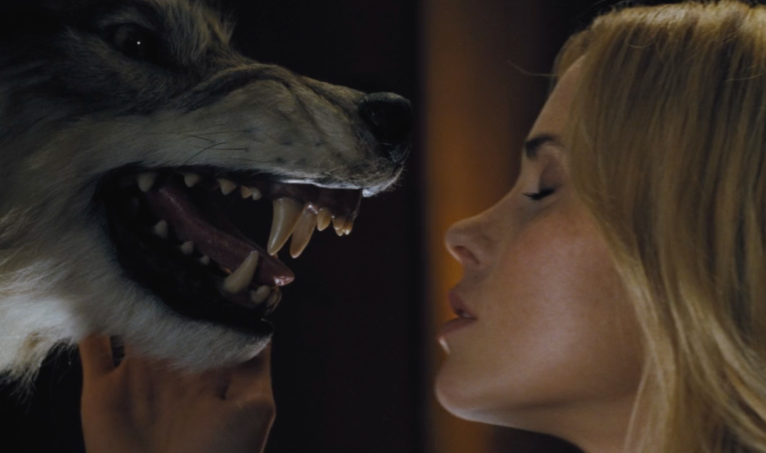
Cabin in the Woods is the epitome of self-aware film, parodying horror cliches while turning the typical fear formula upside down. There are monsters, zombies, masked creeps, agents with guns, grotesque scientific experiments, and more. The film manages to drudge up and reflect on multiple aspects of horror movie lore while sticking to a coherent course. It’s funny, scary, and reflective all at once. It’s an escapist feat that can be either enjoyed for the macabre comedy that it is or revered for its genre-bending commentary.
It’s easy to get define this film as a horror movie due to the gore, guts, and multiple jump scares, but from the dialogue that consistently subverts audience expectation to the bong that doubles as a thermos, the film finds its funny bone. Cabin in the Woods remains one of the most celebrated horror comedies of the 2010s. The film is arguably becoming a modern classic, as it has worked to inspire the proliferation of other contemporary meta-horror films like Jordan Peele’s Get Out and Nope.
More Campy Creepy Creations
- Don’t Tell Mom the Babysitter’s Dead (1991) Five kids are left home alone for the summer when their evil babysitter kicks the bucket. It’s an amusing story with frequent hi-jinks but doesn’t quite live up to its auspicious title.
- House of the Dead (1996, 2003) Attend the rave on a mysterious island, they said. It should be fun, they said. And it was…until the party was taken over by blood-thirsty zombies. In this one, the laughs aren’t exactly intentional…
- Anaconda (1997) A National Geographic film crew is taken hostage and forced to hunt the world’s deadliest snake in this critical-flop-turned-cult-classic film starring Jennifer Lopez, Ice Cube, and Jon Voight. It’s a creature feature loaded with unabashed 90s silliness.
- Bride of Chucky (1998) Chucky meets his perfect match in Jennifer Tilly’s notorious Tiffany, so he turns her into a doll to aid in his killing sprees. At this point in the Child’s Play franchise, the fear factor is almost fully amiss, and all that remains is campy splendor.
- Freddy vs. Jason (2003) What could be more ludicrous than iconic villains Freddy Kreuger and Jason Voorhes in battle? It’s a typical slasher film, but enthusiasts of either franchise will find pleasure in these polar personalities competing.
- House of Wax (2005) The 2005 remake of the 1953 original film (which was an adaptation of 1933’s Mystery of the Wax Museum) finds a group of teens stranded near a wax museum. They must fight to survive and avoid becoming the museum’s next exhibit. An excessive amount of blood and a modicum of self-awareness nearly make up for the inexistent plot.
- Slither (2006) An alien plague takes over a small town, turning its inhabitants into all sorts of monsters and zombies. It’s an homage to low-budget zombie flicks, and, with grandiose grotesqueness, it succeeds in paying tribute to the very films it so admires.
- Jennifer’s Body (2009) Megan Fox stars as a newly-possessed cheerleader out to kill her male classmates. The film was ahead of its time and critically panned, as the feminist movement was not yet as focused on reclaiming one’s body. Female sexual positivity is on display in this clever film boasting several instances of quippy dialogue.
- Tucker & Dale vs. Evil (2010) Hillbillies Tucker and Dale get mistaken for murderers by a group of college students in this horror comedy with a lot of humor and just as much heart.
- The Roommate (2011) One college freshman becomes dangerously obsessed with another in this unintentionally cheap psychological thriller. With few titillating thrills and devoid of any intelligence, this is the kind of camp film that is tragically unaware of its overacting and clichéd execution.
